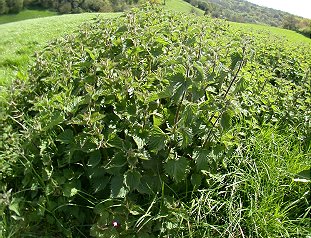 |
The farmer of a British intensive agricultural grassland
therefore aims to have a field dominated by Perennial Ryegrass (PRG). However, in reality
unless action is taken a number of weed species build up over the years. It may then have
to be ploughed up and re-seeded. Typical weeds are docks, nettles, thistles and Couch
Grass. All of these can make significant inroads into the crop yield. In lower yielding
grasslands, dandelions and buttercups may also be present. |
 |
If these weeds are left, large areas of the field will be
lost for grass production. To combat this, the farmer therefore sprays the grassland with
a selective weedkiller. That is, one which will not affect grass. Despite this, the field
may have to be re-seeded to re-establish the dominance of PRG. Whilst the field is being
ploughed, cultivated and re-seeded, it is out of production. It is only when the crop has
become established, that the farmer can use the grass for grazing or silage |
 |
Agricultural grasslands vary depending on a number of
factors. These include the intensity of the fertiliser regime, together with the make-up
of the species in the sward, as well as the harvesting and grazing of the grass. Soil type
and topography also have a great influence on the type of grassland. The wetter and milder
parts of Britain include the counties of Cornwall, Devon, Somerset and parts of Dorset.
These are typically, the more productive grassland areas in Britain. |
|
Continue |
